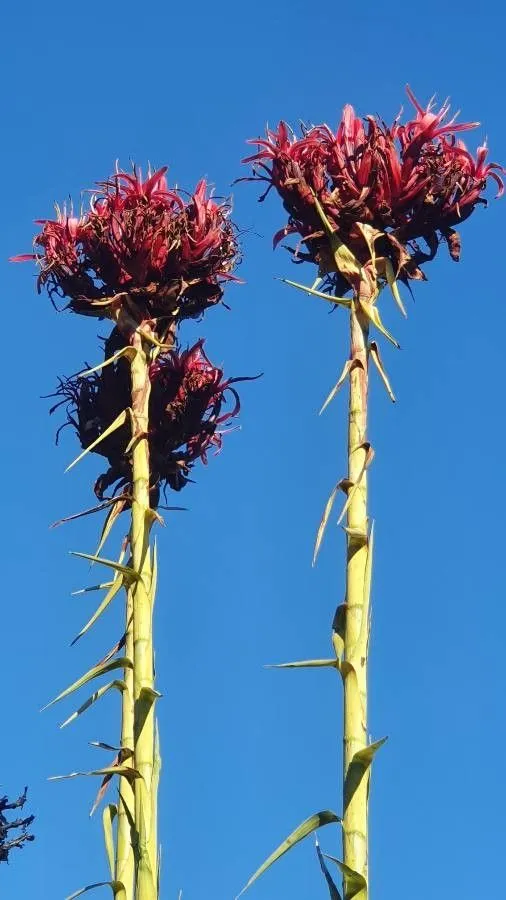
Author: Corrêa
Bibliography: Trans. Linn. Soc. London 6: 213 (1802)
Year: 1802
Status: accepted
Rank: species
Genus: Doryanthes
Vegetable: False
Observations: E. New South Wales
The Gymea lily, scientifically known as Doryanthes excelsa, is a striking and robust plant native to Eastern New South Wales, Australia. Belonging to the family Doryanthaceae, this magnificent perennial is well-known for its dramatic floral displays and substantial size, making it a favorite among horticulturists and garden enthusiasts.
Originating in the early 19th century, the Gymea lily was first described and categorized in 1802 by Corrêa, as documented in the Transactions of the Linnean Society of London. Its towering flower stalks and vibrant, red blossoms make it an unforgettable specimen in the Australian landscape.
Gymea lilies typically thrive in well-drained soils with plenty of sunlight, although they are capable of enduring partial shade. They are well-adapted to the climate of Eastern New South Wales, where they grow naturally in the wild. The plant’s most notable feature is its flowering spike, which can reach impressive heights of up to 6 meters (20 feet). Atop this spike is a cluster of bright red flowers, each about 10 centimeters (4 inches) in diameter. These flowers not only provide a stunning visual appeal but also attract a variety of bird species, especially nectar-feeding birds such as honeyeaters.
The basal rosette of the Gymea lily consists of large, sword-shaped leaves that can extend up to 1 meter (3.3 feet) long. These lustrous green leaves form a dramatic, symmetrical clump that adds to the plant’s architectural beauty even when not in bloom.
Due to its hardy nature and impressive display, the Gymea lily has become a popular choice for ornamental landscaping and public gardens. It requires minimal maintenance once established, making it a resilient and rewarding plant for both novice and experienced gardeners. Additionally, it is often utilized in large-scale landscape projects for its ability to create a bold statement and add vertical interest.
Culturally, the Gymea lily holds significance to the indigenous peoples of the region. It has been used in traditional practices, and its fibrous leaves have historically been employed for weaving and crafting.
In summary, Doryanthes excelsa, or the Gymea lily, is a botanical marvel that exemplifies the unique flora of Eastern New South Wales. Its towering flower stalks, brilliant red blooms, and robust foliage make it an iconic and cherished plant in Australian horticulture.
Eng: gymea-lily, giant-lily
En: Gymea Lily, Flame lily, Giant Lily, Illawarra Lily, Spear Lily, Gymea-lily, Giant-lily
Ar: رمحية سامية
Fr: Lys javelot
: Gymea lily
Taken Oct 13, 2019 by Hendrik Falk (cc-by-sa)
Taken Oct 9, 2022 by Eugene B (cc-by-sa)
Taken Sep 17, 2022 by Karen Goh (cc-by-sa)
Taken Oct 28, 2019 by Margaret Wetzler (cc-by-sa)
Taken Nov 12, 2022 by Audre Audre Newman (cc-by-sa)
© copyright of the Board of Trustees of the Royal Botanic Gardens, Kew.
© copyright of the Board of Trustees of the Royal Botanic Gardens, Kew.
© copyright of the Board of Trustees of the Royal Botanic Gardens, Kew.
Taken Oct 28, 2019 by Margaret Wetzler (cc-by-sa)
Taken Sep 20, 2021 by Samantha Halverson (cc-by-sa)
Family: Myrtaceae Author: (F.Muell.) K.D.Hill & L.A.S.Johnson Bibliography: Telopea 6: 402 (1995) Year: 1995 Status:…
Family: Rubiaceae Author: Pierre ex A.Froehner Bibliography: Notizbl. Bot. Gart. Berlin-Dahlem 1: 237 (1897) Year:…
Family: Sapindaceae Author: Koidz. Bibliography: J. Coll. Sci. Imp. Univ. Tokyo 32(1): 38 (1911) Year:…
Family: Asteraceae Author: A.Gray Bibliography: Pacif. Railr. Rep.: 107 (1857) Year: 1857 Status: accepted Rank:…
Family: Fabaceae Author: Medik. Bibliography: Vorles. Churpfälz. Phys.-Ökon. Ges. 2: 398 (1787) Year: 1787 Status:…
Family: Aspleniaceae Author: (Cav.) Alston Bibliography: Bull. Misc. Inform. Kew 1932: 309 (1932) Year: 1932…